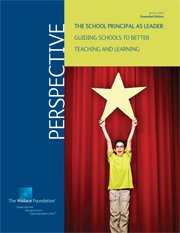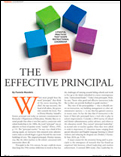The Principal Story Learning Guide
To advance the professional learning of aspiring and current school leaders

Unit 2: Creating a climate hospitable to education
Purpose: Unit 2 gives participants an opportunity to identify principal behaviors that contribute to a healthy instructional climate. Such behaviors include developing an atmosphere of caring and trust, focusing on instruction, and building a sense of school community. Approximate Time: 4.5 – 5.25 hours.
Facilitators: Adult learning professionals may use this web-based learning tool in principal preparation courses or in workplace study sessions. Facilitators may encourage participants to take advantage of the writable PDFs to record and save their responses. For onsite study groups or classes, the facilitator may choose to print relevant worksheets and provide them to participants. Depending on class structure and learning goals, facilitators will use these tools to provide group and individual learning experiences within the following structure:
| Consider ideas and connect with others | |
| Watch the film clip | |
| Read the excerpt | |
| Complete the activities |
Consider ideas and connect with others
Before viewing the documentary film clip, think about the role of a school principal in creating a climate hospitable to education. Independently, respond to questions on the worksheet and exchange responses with a partner. Connect with others, if applicable, to discuss common themes.
- Describe the relationship between a positive, hospitable climate and student achievement.
- What does it mean for principals to create a climate hospitable to education?
- What examples or results of such a climate can you share from your own experience?
Watch the film clip
View a clip on creating an environment hospitable to education to see research in practice. Use the Big ideas chart to guide note-taking while viewing.
Observe principals Tresa Dunbar (Nash Elementary) and Kerry Purcell (Harvard Park) grapple with balancing student discipline with the need to nurture children and give them the means to a successful future. [Time: 7 minutes, 22 seconds]
Read the excerpt
The School Principal as Leader: Guiding Schools to Better Teaching and Learning (The Wallace Foundation, 2013), 8–9.
Download excerpt in PDF format.
The Wallace Foundation research and work on school leadership since 2000 suggests that principals must become “leaders of learning who can develop a team delivering effective instruction.” This skill set entails five key, interrelated responsibilities. One responsibility is “creating a climate hospitable to education in order that safety, a cooperative spirit and other foundations of fruitful interaction prevail.”1
More than a decade of research confirms that effective principals ensure that their schools allow both adults and children to put learning at the center of their daily activities. Such “a healthy school environment,” as Vanderbilt researchers call it, is characterized by basics like safety and orderliness, as well as less tangible qualities such as a “supportive, responsive” attitude toward the children and a sense by teachers that they are part of a community of professionals focused on good instruction.2
Is it a surprise, then, that principals at schools with high teacher ratings for “instructional climate” outrank other principals in developing an atmosphere of caring and trust? Or that their teachers are more likely than faculty members elsewhere to find the principals’ motives and intentions are good?3
One former principal, in reflecting on his experiences, recalled a typical staff meeting years ago at an urban school where “morale never seemed to get out of the basement.” Discussion centered on “field trips, war stories about troubled students, and other management issues” rather than matters like “using student work and data to fine-tune teaching.” Almost inevitably, teacher pessimism was a significant barrier, with teachers regarding themselves as “hardworking martyrs in a hopeless cause.”4
To change this kind of climate — and begin to combat teacher isolation, closed doors, negativism, defeatism, and teacher resistance — the most effective principals focus on building a sense of school community, with the attendant characteristics. These include respect for every member of the school community; “an upbeat, welcoming, solution-oriented, no-blame, professional environment;” and efforts to involve staff and students in a variety of activities, many of them schoolwide.5
Complete the activities
Working in small groups or at their own pace, learners observe, discuss, engage, and reflect on the ideas and information presented in the film clips and related materials. Follow these links to tools that include writable PDF files to support this work.
| Activity 1: Discover personal assumptions | |
| Activity 2: Review research | |
| Activity 3: Link research with practice | |
| Activity 4: Take action | |
| Activity 5: Reflect |
Footnotes
1. The Wallace Foundation, The School Principal as Leader: Guiding Schools to Better Teaching and Learning Report, The Wallace Foundation, 2013, 6.
2. Ellen Goldring, Andrew C. Porter, Joseph Murphy, Stephen N. Elliott, Xiu Cravens, Assessing Learning-Centered Leadership: Connections to Research, Professional Standards and Current Practices, Vanderbilt University, 2007, 7-8.
3. Karen Seashore Louis, Kenneth Leithwood, Kyla L. Wahlstrom and Stephen E. Anderson, Learning From Leadership: Investigating the Links to Improved Student Learning: Final Report of Research Findings, University of Minnesota and University of Toronto, 2010, 81.
4. Michael S. Knapp, Michael A. Copland, Meredith I. Honig, Margaret L. Plecki and Bradley S. Portin, Learning-Focused Leadership and Leadership Support: Meaning and Practice in Urban Systems, University of Washington, 2010, 1. Citing Kim Marshall from “A Principal Looks Back: Standards Matter,” Ihi Delta Kappan, October 2003, 104-113, and noting Marshall is also cited in Charles M. Payne’s So Much Reform, So Little Change: The Persistence of Failure in Urban Schools, 2008, 33-34.
5. Bradley S. Portin, Michael S. Knapp, Scott Dareff, Sue Feldman, Felice A. Russell, Catherine Samuelson and Theresa Ling Yeh, Leadership for Learning Improvement in Urban Schools, University of Washington, 2009, 59.
About
The Principal Story Learning Guide
Required Text
The Wallace Foundation. (2013). The school principal as leader: Guiding schools to better teaching and learning. New York: Author.
Optional Texts
Mendels, P. (2012, February). The effective principal. JSD, 33(1), 54-58.
Seashore-Louis, K., Leithwood, K., Wahlstrom, K., & Anderson, S.E. (2010). Learning from Leadership: Investigating the Links to Improved Student Learning. New York: The Wallace Foundation.
THE PRINCIPAL STORY
Offered in
collaboration with:





